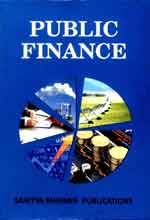|
बी काम - एम काम >> पब्लिक फाइनेन्स पब्लिक फाइनेन्सडॉ. एस के सिंहडॉ. जे पी मिश्रा
|
|
||||||
बी काम के विद्यार्थियों हेतु पाठ्य पुस्तक
CONTENTS
1. Meaning And Scope Of Public Finance ... 1-8
Meaning; Public Finance and Private Finance; Scope of Public Finance, New Public Finance; Questions.
2. Public Goods And Private Goods ... 9-14
Definition of Public and Private Goods; Social Goods; Merit Goods and Demerit Goods; Mixed Goods; Club Goods; Global Public Goods; Questions.
3. Principle Of Maximum Social Advantage ... 15-18
Introduction: Explanation of the Principle of Maximum Social Advantage; Tests of Social Advantage; Limitations of the Principle; Questions.
4. Government Budget : Definition. Evolution, Theory, Classification And Innovation ... 19-32
Definition; Evolution and Purposes of Budgeting, Budgetary Theory; Balanced Budget, Modern Approach and Case of Developing Countries; Kinds of Budgets; Techniques of Budgeting : PPBS and ZBB; Questions.
5. Deficit Financing ... 33-38
Introduction: Meaning of Deficit Financing; Effect of Deficit Financing; Current Usage of Budgetary Deficit; Questions.
6. Taxable Capacity ... 39-43
Introduction. Absolute Taxable Capacity and Relative Taxable Capacity; Conclusion; Questions.
7. Public Expenditure : Meaning, Nature And Causes Of Increase ... 44-51
Meaning; Nature; Causes of Increase : Wagner's Law, Peacock-Wiseman Hypothesis, Income Elasticity of Demand, Technical Change, Evolution of Democracy, Effects of War and Defence Preparations, Role of Government, Imbalance in Productivity Growth; Questions.
8. Canons And Classification Of Public Expenditure ... 52-57
Canons; Classification : Dalton, Pigou, Adam. Shirras, Nicholson, and Present Uses; Questions.
9. Effects Of Public Expenditure On Production, Distribution And Economic Stability ... 58-64
Distribution and Economic Stability Introduction, Effects on Production: Distribution and Economic Stability: Anti-inflationary Policy; Questions.
10. Sources Of Public Revenue ... 65-71
Public Receipts and Public Revenue; Sources of Public Revenue: Taylor's Approach, De Viti's Approach and Seligman's Approach; Present-day Usage; Questions.
11. Classification Of Tax Revenue: Direct And Indirect Taxes ... 72-76
Introduction; Direct and Indirect Taxes; Different Ways of Defining Direct and Indirect Taxes; Other Classification of Taxes; Balance between Direct and Indirect Taxes; Questions.
12. Progressive, Proportional And Regressive Taxes ... 77-83
Progressive, Proportional and Regressive Concept of Taxes; Proportional Versus Progressive Taxes; Progressive Taxation: Merits and Demerits; Questions.
13. Shifting And Incidence Of Taxation ... 84-91
Introduction, Traditional Concept; Current Approach to Incidence; (1) Lady Hicks on Incidence; (2) Development of Incidence Theory since 1950s; Murgrave's Concept of Incidence; Questions.
14. Shifting And Incidence Of Commodity Taxes ... 92-98
Tradition View; Short-run and Long-run Adjustment in Pure Competition; Shifting under Monopoly; Questions.
15. Different Forms Of Taxes ... 99-106
Forms of Taxes : Income Tax, Agriculture Taxation, Wealth Tax, Urban Property Tax, Expenditure Tax; Commodity Taxes; Excise Taxation, Sales Taxation, Taxes on International Trade; Questions.
16. Value Added Tax (Vat) And Goods And Services Tax (GST) ... 107-114
1. VAT : Features, Different Forms, Merits and Demerits of VAT; VAT in India; 2. GST; Questions.
17. Effects Of Tax On Production And Distribution ... 115-128
Effects on Production: on Efficiency; on Distribution: Questions.
18. Problems Of Justice In Taxation ... 129-135
Introduction; Benefit Principle: Ability-to-pay Principle: Index of Ability-topay; Requirements of a Good Tax System; Questions.
19. Public Debt: General Consideration ... 136-146
Introduction; Role of Public Debt: Classical System, Keynesian System; Post-Keynesian View; Recent Thinking: Role in a Developing Economy; Conclusion; Classification of Public Debt; Techniques of Public Borrowing; Economic Effects of Public Debt; Questions.
20. Methods Of Redemption Of Public Debt ... 147-151
Introduction; Debt Repudiation; Refunding; Conversion; Sinking Fund; Capital Levy; Questions.
21. Indian Federal Finance Under The Constitution ... 152-168
Federal Concept, Economic Aspect of Federalism; Case of Noncorrespondence; Vertical and Horizontal Fiscal Imbalances; Development of Fiscal Federalism in India; Before 1935 and Under the Indian Constitution; Financial Adjustment under the Constitution; Institution of Finance Commission; Questions.
22. Indian Finance Commission ... 169-183
Introduction; Terms of Reference; Devolution of Financial Resources from Centre to States; Grants-in-aid; Pattern of Fiscal Transfers, Conclusion; Questions,
23. Review Of The Indian Tax System ... 184-199
Sources of Central and State Tax Revenue; Central Tax Revenue; Structural Changes in Central Tax Revenue; State Tax Revenue; Structural Changes in States' Own Tax Revenue; Buoyancy of Central and State Taxes; Restructuring of Central and States' Own Tax Revenue since 1991; Questions.
24. Budgetary Procedure And Financial Control In India ... 201-216
Introduction; Preparation of Budget in India; Implementation of the Budget; Budget Reporting and Evolution; Audit; Parliamentary Committees; Questions.
25. Review Of India's Public Expenditure : Central And States ... 217-223
Central Government Expenditure; Growth of State Expenditure; Questions.
26. Public Debt Of India ... 224-231
Public Debt of the Government of India; India's External Debt; Debt Position of States; Questions.
27. Goods And Service Tax - GST ... 232-247
Concept of GST; Need for GST in India; Framework of GST as Introduced in India: Taxes Subsumed in GST; Computation of GST Intra-State Supply; Rates of GST; Negative List under GST; Benefits of GST; Impact of GST; Questions.
28. Union Budget 2018-19 ... 248-253
Highlights of Union Budget 2018-19: Overview of the economy; Agriculture and Rural Economy; Health, Education and Social Protection; Medium, Small and Micro Enterprises (MSMEs); Employment Generation; Infrastructure and Financial Sector Development; Railways; Digital Economy; Disinvestment: Fiscal Management.
|
|||||

 i
i 










